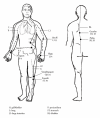Neuroendocrine mechanisms of acupuncture in the treatment of hypertension
- PMID: 22216059
- PMCID: PMC3246758
- DOI: 10.1155/2012/878673
Neuroendocrine mechanisms of acupuncture in the treatment of hypertension
Abstract
Hypertension affects approximately 1 billion individuals worldwide. Pharmacological therapy has not been perfected and often is associated with adverse side effects. Acupuncture is used as an adjunctive treatment for a number of cardiovascular diseases like hypertension. It has long been established that the two major contributors to systemic hypertension are the intrarenal renin-angiotensin system and chronic activation of the sympathetic nervous system. Recent evidence indicates that in some models of cardiovascular disease, blockade of AT1 receptors in the rostral ventrolateral medulla (rVLM) reduces sympathetic nerve activity and blood pressure, suggesting that overactivity of the angiotensin system in this nucleus may play a role in the maintenance of hypertension. Our experimental studies have shown that electroacupuncture stimulation activates neurons in the arcuate nucleus, ventrolateral gray, and nucleus raphe to inhibit the neural activity in the rVLM in a model of visceral reflex stimulation-induced hypertension. This paper will discuss current knowledge of the effects of acupuncture on central nervous system and how they contribute to regulation of acupuncture on the endocrine system to provide a perspective on the future of treatment of hypertension with this ancient technique.
Figures



Similar articles
-
Repeated electroacupuncture attenuating of apelin expression and function in the rostral ventrolateral medulla in stress-induced hypertensive rats.Brain Res Bull. 2013 Aug;97:53-62. doi: 10.1016/j.brainresbull.2013.05.013. Epub 2013 Jun 7. Brain Res Bull. 2013. PMID: 23751198
-
What do we understand from clinical and mechanistic studies on acupuncture treatment for hypertension?Chin Med. 2015 Nov 30;10:36. doi: 10.1186/s13020-015-0070-9. eCollection 2015. Chin Med. 2015. PMID: 26628909 Free PMC article.
-
Angiotensin-(1-7) enhances the effects of angiotensin II on the cardiac sympathetic afferent reflex and sympathetic activity in rostral ventrolateral medulla in renovascular hypertensive rats.J Am Soc Hypertens. 2015 Nov;9(11):865-77. doi: 10.1016/j.jash.2015.08.005. Epub 2015 Aug 20. J Am Soc Hypertens. 2015. PMID: 26428223
-
Central neural regulation of cardiovascular function by angiotensin: a focus on the rostral ventrolateral medulla.Neuroendocrinology. 2009;89(4):361-9. doi: 10.1159/000197863. Epub 2009 Jan 28. Neuroendocrinology. 2009. PMID: 19174604 Review.
-
Role of angiotensin II receptors in the regulation of vasomotor neurons in the ventrolateral medulla.Clin Exp Pharmacol Physiol. 2002 May-Jun;29(5-6):467-72. doi: 10.1046/j.1440-1681.2002.03658.x. Clin Exp Pharmacol Physiol. 2002. PMID: 12010194 Review.
Cited by
-
Effect of Scurrula atropurpurea on nitric oxide, endothelial damage, and endothelial progenitor cells of DOCA-salt hypertensive rats.Iran J Basic Med Sci. 2014 Aug;17(8):622-5. Iran J Basic Med Sci. 2014. PMID: 25422757 Free PMC article.
-
Effect of electroacupuncture in postanesthetic shivering during regional anesthesia: a randomized controlled trial.BMC Complement Altern Med. 2012 Nov 27;12:233. doi: 10.1186/1472-6882-12-233. BMC Complement Altern Med. 2012. PMID: 23181618 Free PMC article. Clinical Trial.
-
Efficacy of acupuncture for hypertension in the elderly: a systematic review and meta-analysis.Front Cardiovasc Med. 2023 Dec 14;10:1147135. doi: 10.3389/fcvm.2023.1147135. eCollection 2023. Front Cardiovasc Med. 2023. PMID: 38162142 Free PMC article. Review.
-
Role of the hypothalamic arcuate nucleus in cardiovascular regulation.Auton Neurosci. 2013 Apr;175(1-2):38-50. doi: 10.1016/j.autneu.2012.10.016. Epub 2012 Dec 19. Auton Neurosci. 2013. PMID: 23260431 Free PMC article. Review.
-
A Time-Dependent Analysis of Association between Acupuncture Utilization and the Prognosis of Ischemic Stroke.Healthcare (Basel). 2022 Apr 19;10(5):756. doi: 10.3390/healthcare10050756. Healthcare (Basel). 2022. PMID: 35627893 Free PMC article.
References
-
- Hajjar I, Kotchen TA. Trends in prevalence, awareness, treatment, and control of hypertension in the United States, 1988–2000. Journal of the American Medical Association. 2003;290(2):199–206. - PubMed
-
- Vasan RS, Beiser A, Seshadri S, et al. Residual lifetime risk for developing hypertension in middle-aged women and men: the Framingham Heart Study. Journal of the American Medical Association. 2002;287(8):1003–1010. - PubMed
-
- Esler M, Rumantir M, Kaye D, Lambert G. The sympathetic neurobiology of essential hypertension: disparate influences of obesity, stress, and noradrenaline transporter dysfunction? American Journal of Hypertension. 2001;14(6):139S–146S. - PubMed
-
- Acupuncture Research Group of An Hui Medical University. Primary observation of 179 hypertensive cases treated with acupuncture. Acta Universitatis Medicinalis Anhui. 1961;4:p. 6.
-
- Zhang CL. Clinical investigation of acupuncture therapy. Clinical Journal of Medicine. 1956;42:514–517.
LinkOut - more resources
Full Text Sources
Research Materials

